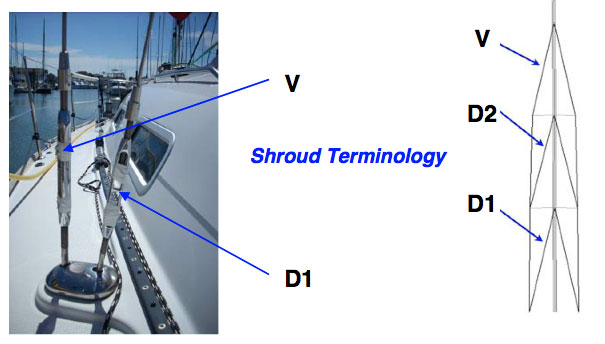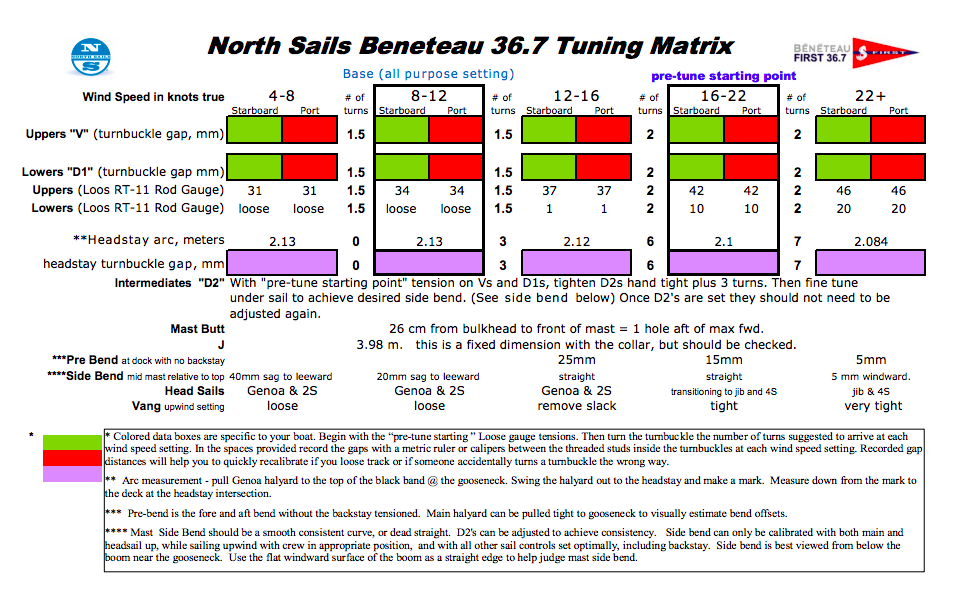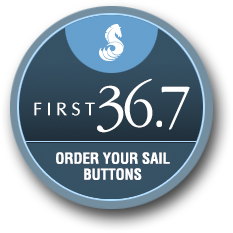North Sails Tuning Guide
Beneteau First 36.7 One Design
Development:
North Sails began working with 36.7 sails as soon as the first boat was launched in 2001. Since then we have continuously refined our shapes through incremental improvement. Each minor adjustment complimented the previous, and each tweak became ever more minor. Today, our sail shapes have matured to a point where it is hard to imagine a "break through". Our class sails are very light, exceptionally smooth, extremely durable, and easy to make go fast. Of course we will continue our quest for perfection, but we feel that it is just as important to disclose our latest tuning developments. North sails will out perform all others, but to get the most out of them they need to be set properly.
Sail development does not happen in isolation. It evolves in tandem with a mast tuning strategy. By contorting mast bend and headstay sag you can enhance, or degrade, your boatÂs performance. Different conditions require different optimal rig settings. Proper rig tune is an essential part of the game, every bit as important as puffs, or wind shifts. This guide will give you the information you need to begin the quest for perfect tune. The information provided hear has been tested and has proven to be very fast, but the factors that effect sailboats can be very subtle and extremely complex. Mast tuning interacts with an infinite array of surface conditions and a wide variety of human skills. Therefore, it is expected that similar results may be achieved through divergent methodologies. As you gain confidence with the settings within this guide feel free to experiment. In order to recognize how your boat should feel when it is performing well you need to appreciate how it feels when it is not.
A few words need to be said in appreciation of the "unseen" people behind our Beneteau 36.7 project. It isnÂt any secret that the best and the brightest people in sailmaking work for North Sails. The North Sails family is an incredibly clever and cohesive team. We bring hard work, and hard science, to the task of improving sails and sailing. The same people who create magnificent AmericaÂs Cup sails are at the hart of our Beneteau 36.7 project. They represent a vast, and often unseen resource. If you are interested in the process of sail development, and the state of our science, feel free to browse through our web site www.northsails.com, or contact your nearest sales rep. They will be happy to speak about our latest innovations. In the mean time letÂs get on with optimizing your boat for North Sails.
Tuning strategy:
Many people will prefer one all purpose mast setting and leave it there all season. That is a perfectly acceptable and safe way to enjoy your Beneteay 36.7. North CDP (Class Development Program) sails have won many races using just the 8-12 Knot base setting. For the more discerning eye, or sailing in heightened competition, there are ways to tweak your mast to get a little extra performance. This guide was created for those inquisitive, and competitive people who are looking for that little "extra". Below is an overview of our tuning goals and a description of how to achieve them.
If we imagine that there are no leeward shrouds while sailing up wind we can picture how the caps (VÂs) and diagonals (DÂs) affect the side bend of a mast. The caps travel through the spreader tips to the top of the mast. As the windward V is tightened it tends to push the spreader to leeward and pull the tip of the mast to windward. (spooning) As the Ds are tightened they do the opposite. They pull the middle of the mast up to windward. If the DÂs are over tightened they will pull the mid mast too far to windward and dump the tip to leeward. (tip fall off) A good guide for general shroud tension is that the leeward V should just go slack in all but the heaviest of wind conditions, and the DÂs should keep the mast "in column" side to side. This insures that we donÂt have unnecessary compression on the mast, and that the mast is not leaning to leeward.
However, the addition of backstay tension will upset things. Adding backstay causes two noticeable affects on your shroud tensions. As the mid-mast bends forward the total mast height will be reduced. This will cause the VÂs to loosen. Also, as the mid-mast moves forward and away from the chain plates the DÂs will get tighter. The result is that when we apply backstay, the tighter DÂs pull the mid-mast too far to windward, and the looser Vs allow the mast tip to sag to leeward. Therefore, every backstay increment requires a corresponding set of shroud tensions to keep the mast in column. Of course that is not a practical solution because the backstay has infinite adjustment between all the way off and all the way on. So our goal is to cover the backstay range with 4 sets of corresponding shroud tensions. We pick a setting dependant on how much backstay we might use during the race. Since we start useful backstay tension at around 12 to 14 knots, we include a fifth set of tensions for use during very low wind speeds. At those light air settings our focus switches towards inducing headstay sag and compressing the slot by spooning the mast.

Base Rig Set-Up:
1) Mast Butt  Proper mast butt location is the first critical step . We have found that a good starting point is to place the mast butt so that the forward edge of the mast is 26cm from the bulkhead. This should be one hole aft of max forward on the step, but you should check the bulkhead measurement to be sure. You may need to slightly modify the floorboards that sit around the mast.
2)Headstay Length  The headstay length controls both the tilt of the mast (mast rake) and the bend of the mast around the partners (pre-bend). Use the arc method described in the tuning matrix to set your head stay length.
3) Center the Mast - a. Put a mark on the rail of the boat on one side even with the chain plates. Measure from this mark to the center of the headstay attachment on the bow. b.Put a corresponding mark on the other side, the same distance from the headstay. c. Set the Upper Shroud (Caps, or Vs) tension to a few turns tighter than hand tight. The Intermediates (D2s) and the Lowers (D1s) should be totally loose, with lots of sag. d.Hoist the tape measure to the top on the centerline jib halyard. Measure to the marks on either side and adjust the Caps until they are equal. Put your eye close to the mast track on the aft side of your mast. Look up the mast track. There might be a slight fore and aft bend, but the mast should be straight, side to side. If it is not perfectly straight side to side then repeat step 3. If it is still not straight then it may be that the mast butt, the partners, and, or, the hounds (upper termination of the upper shrouds) may not be on the same plane. If one of them is slightly out of line a slight mast bow to one side will be the symptom. e. Adjust one of the three nodes until the mast is perfectly straight side to side.
4) If there is any backstay tension release the backstay all the way until the backstay sags. It may mean that you have to unshackle the backstay purchase to lengthen the backstay.
5)Tension the upper shrouds This is not your base setting! This is just to give the shrouds enough tension so that the loose guage will work properly. Tension the VÂs until they reach 42 units on the Loos RT-11 gauge.
6) Tension the lower (D1Âs) until they reach 10 units on the Loos RT-11 gauge.
7)Tighten the D2s (intermediate shrouds) to hand tight so that all the slack is removed. Then add three additional full turns. The D2Âs are on top of the spreaders and are difficult to adjust. DO NOT ROTATE THE ROD RIGGING. It only takes a few rotations of the rod to crack the D2Âs. Hold the barrel of the turnbuckle and turn the threaded stud below the barrel. Use appropriate tools.
8) Check to see if the VÂs and D1Âs are still at 42 and 10 respectively. Adjust symmetrically if needed. Also check to see if the mast is still straight side to side, or "in column. If it is badly out of column start over from step 3. Someone probably turned one of the turnbuckles the wrong way. If it is only slightly out of column then maybe a half turn on the appropriate D1 or a few turns on the D2Âs will pull it back to straight side to side. Again, This is not your base setting! Use the tuning matrix to set for the appropriate wind range.
9) Go sailing, preferably in wind strong enough to pressurize the rig, but not so much that you need to apply a lot of backstay tension. (ideally 12-14 knots) While sailing upwind in "race mode" with the crew hiking etc. sight up the mast. The D2s may need to be adjusted either way to maintain the mast in column. New rigging will stretch a surprising amount, so recheck and adjust often as needed. Eventually the rod rigging will settle down and the D2Âs will not have to be adjusted further.
10) With a small metric ruler or caliper record the gap distance between the threaded studs inside the various turnbuckles. (Vs, D1s, and Headstay) Right them down in the space provided in North Tuning Matrix (shaded boxes) under the pre-tune starting point . Adjust the turnbuckles up and down the matrix to the various settings and record the gap distances in the colored boxes provided.

Sighting the side to side bend of the mast while sailing upwind in "race mode" Note that you can use the windward surface of the boom as a straight edge

